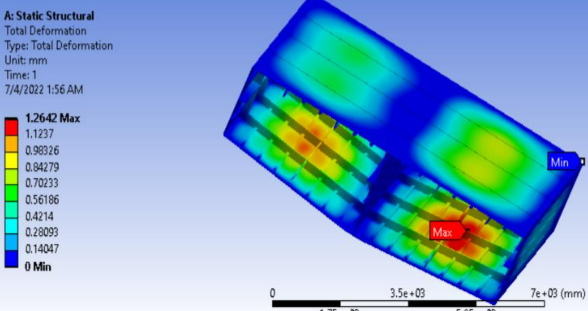A Finite Element Analysis of Bottom Structure of LCT Converted from SPOB
Main Article Content
Abstract
SPOB (Self-Propelled Oil Barge) ship is useful for transporting oil. Due to certain requests, the owner and operator have converted SPOB into LCT. If before the conversion the ship transported oil, now the ship is transporting vehicles or heavy equipment on the deck. after the transfer of function from a SPOB ship to an LCT (Landing Craft Tank) ship, the cargo transported is different, the bottom is the part that is submerged in the water, so this part is vulnerable. Therefore, it is necessary to systematically predict the weight of the load that can be held by the ship at the bottom, this is so that there is no damage to the structure at the bottom of the ship which can harm the company from the ship owner. The purpose of this study is to find the maximum stress and strain that can be accepted by the ship and the value of the stress ratio (safety factor) in the bottom construction using the finite element method. The results obtained from the maximum stress and strain of the ship after and before conversion of 96.349Mpa, 272.56 Mpa, and 0.0013628 mm, 5.042 x 10-4 mm, safety factor according to BKI after and before conversion obtained 3.624 and 1.057, the safety factor according to the material criteria is 3.685 and 1.172, respectively, for the maximum deformation of the ship, the safety factor is 6.328 and 3.287 respectively
Downloads
Article Details

This work is licensed under a Creative Commons Attribution 4.0 International License.
References
R. Amanu, “Analysis of The Effect of Lct (Landing Craft Tank) Ship Transfer to SPOB (Self Propelled Oil Barge) on IMO Criteria Regarding Ship Stability,” Politeknik Perkapalan Negeri Surabaya, 2021. [In Bahasa]
A. I. Wulandari, Alamsyah, and C. L. Agusty, “Stress-strain Analysis on the Deck and Bottom Plates of Ro-Ro Ferry Ships Using Finite Element Method,” Wave J. Ilm. Teknol. Marit., vol. 15, no. 1, pp. 45–52, 2021, doi: 10.29122/jurnalwave.v15i1.4782. [In Bahasa]
M. Mekel, “Analysis of stress and strain by varying the longitudinal distance of the inner bottom of container ships using the finite element method,” Institut Teknlogi Kalimantan, 2021. [In Bahasa]
M. U. Pawara, A. Alamsyah, R. J. Ikhwani, A. R. Siahaan, and A. M. Nugraha Arifuddin, “A Finite Element Analysis of Structural Strength of Ferry Ro-Ro’s Car Deck,” INVOTEK J. Inov. Vokasional dan Teknol., vol. 22, no. 1, pp. 47–60, 2022, doi: 10.24036/invotek.v22i1.959.
A. Alam, A. B. Mapangandro, Amalia Ika W, and M U Pawara, “Fatigue Life Analysis of Ramp Door Ferry Ro-Ro Gt 1500 Using Finite Element Method,” Maj. Ilm. Pengkaj. Ind., vol. 15, no. 1, pp. 42–49, 2021, doi: 10.29122/mipi.v15i1.4744.
A. Alamsyah, S. D. Nurcholik, S. Suardi, M. U. Pawara, and J. Jumalia, “The Strength and Fatigue Life analysis of Sedan Car Ramp of The Ferry Ro-Ro 5000 GT Using Finite Element Method,” J. Ilmu Pengetah. danTeknologi Kelaut., vol. 18, no. 2, pp. 101–110, 2021.
A. I. Wulandari, “Analysis of longitudinal strength on the deck of a 409 TEU container ship using the finite element method,” vol. 16, pp. 17–22, 2022. [In Bahasa]
A. I. Wulandari, A. Mursid, N. Arifuddin, and N. Huda, “Analysis on Deck Ship Conversion SPOB to LCT 234 GT Using Finite Element Method,” vol. 7, no. 3, 2022.
G. J. Bruce and D. J. Eyres, Ship Construction, Seventh. The Boulevard, Langford Lane, Kidlington, Oxford, OX5 1GB: Elsevier Ltd, 2012.
A. I. Wulandari, A. M. N. Arifuddin, and A. M. A. Nudi, “Analysis of Fatigue Life of Spob Ship Cargo Structure Due to Sloshing Load,” vol. 10, no. 2, 2021, [Online]. Available: http://repository.itk.ac.id/17080/%0Ahttp://repository.itk.ac.id/17080/14/09171018_chapter_2.pdf. [In Bahasa]
A. Siagian, Andreas R. H., Mulyanto, I.P., Belian, “Shear Stress Analysis of 6500 Dwt Crude Oil Tanker Ring Structure Based on Finite Element Method,” J. Tek. Perkapalan, vol. 3, no. 2, pp. 309–318, 2015. [In Bahasa]

